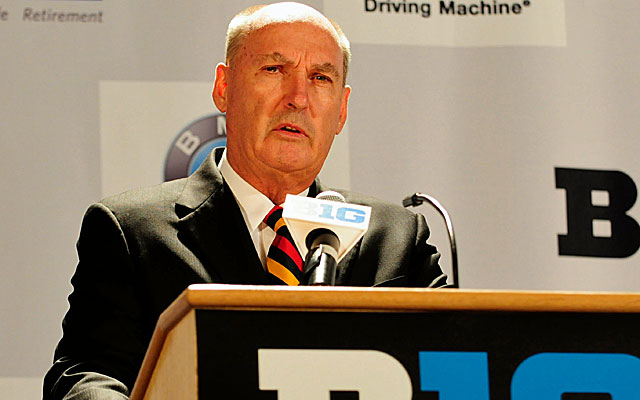
As expected, the Legends and Leaders are no more.
The Big Ten officially announced a thorough overhaul of the league's divisions on Sunday, splitting the conference along geographic lines into brand-new East and West divisions in the wake of its 2012 expansion with Maryland and Rutgers.
In another expected move, the league also announced it would be moving to a nine-game conference schedule in 2016.
As previously reported, the East will be made up of traditional Big Ten powers Ohio State and Michigan -- now in the same division after a separation in the Legends/Leaders format -- along with the Scarlet Knights and Terrapins, Penn State, Michigan State and Indiana. Wisconsin, Minnesota, Iowa, Illinois, Nebraska, Northwestern and Purdue make up the Big Ten West.
“Big Ten directors of athletics concluded four months of study and deliberation with unanimous approval of a future football structure that preserved rivalries and created divisions based on their primary principle of East/West geography,” commissioner Jim Delany in a statement released by the league. “The directors of athletics also relied on the results of a fan survey commissioned by BTN last December to arrive at their recommendation, which is consistent with the public sentiment expressed in the poll.”
(So, fans, all that online voting you did really mattered after all, apparently.)
The Big Ten schedule will consist of an intra-division round-robin with two temporary cross-divisional matchups per team in 2014 and 2015. In 2016, the league will increase that number to three rotating cross-division matchups, with one notable expection -- Indiana and Purdue, who will play a protected, annual cross-divisional game to preserve the Old Oaken Bucket rivalry.
The Legends and Leaders divisions were announced in December 2010 and immediately drew calls for a do-over from fans and pundits alike, thanks to both the abstract, corporate-sounding aspect of their names and the seemingly arbitrary team assignments, some of which disrupted some of the Big Ten's oldest rivalries.
After an initial burst of insisting the names weren't as disliked as widely believed and that the Big Ten would not be changing either the divisional assignments or the names, Delany slowly distanced the league from the names -- after the additions of Maryland and Rutgers, the changes became all but a foregone conclusion, with none other than Delany himself joking about the names at the recent BCS playoff meetings.
The complete announcement from Delany and the Big Ten:
The Big Ten Conference office announced football division alignments set to begin in 2014 and nine-game conference schedules set to start in 2016. The changes were unanimously recommended by conference directors of athletics and supported by the Big Ten Council of Presidents/Chancellors.
“Big Ten directors of athletics concluded four months of study and deliberation with unanimous approval of a future football structure that preserved rivalries and created divisions based on their primary principle of East/West geography,” said Big Ten Commissioner James E. Delany. “The directors of athletics also relied on the results of a fan survey commissioned by BTN last December to arrive at their recommendation, which is consistent with the public sentiment expressed in the poll.”
The new division alignments will feature Indiana, Maryland, Michigan, Michigan State, Ohio State, Penn State and Rutgers in the East Division and Illinois, Iowa, Minnesota, Nebraska, Northwestern, Purdue and Wisconsin in the West Division. All schools in the East Division are in the eastern time zone and all schools in the West Division are in the central time zone with the exception of Purdue. Each school will play the other six schools in its division plus two teams from the other division in 2014 and 2015, which will serve as transitional years in which the schools will still be playing eight-game schedules. Beginning in 2016, each school will play three teams from the other division as part of its nine-game schedule. The cross-division games will include one protected matchup on an annual basis between Indiana and Purdue.
With the start of the nine-game conference schedule in 2016, teams from the East Division will host five conference home games during even-numbered years, while teams from the West Division will host five conference home games during odd-numbered years. As a result of the nine-game conference schedule and the Big Ten’s schedule rotation, every student-athlete will have the opportunity to play against every other team in the conference at least once during a four-year period. The Big Ten is returning to a nine-game conference schedule for all teams for the first time since the 1983 and 1984 seasons.
“Big Ten directors of athletics met in person or by conference call six times from December to March to discuss a new Big Ten football model,” Delany said. “The level of cooperation and collaboration was reflective of what we've come to expect from this group of administrators who have worked extremely well together on a number of complex matters over the past several years. We are all looking forward to ushering in this new era of Big Ten football.”
The Big Ten will hold the 2013 Football Media Days and 42nd annual Kickoff Luncheon on Wednesday and Thursday, July 24 and 25, at the Hilton Chicago, featuring all 12 head coaches and some of the nation’s top returning players. The 118th season of Big Ten football kicks off Thursday, August 29, and culminates with the third annual Big Ten Football Championship Game on Saturday, Dec. 7, to be played at Lucas Oil Stadium in Indianapolis and televised by FOX. The winner of the title game will earn the Big Ten Championship and a chance to play in either the Rose Bowl Game or Bowl Championship Series National Championship Game.




















